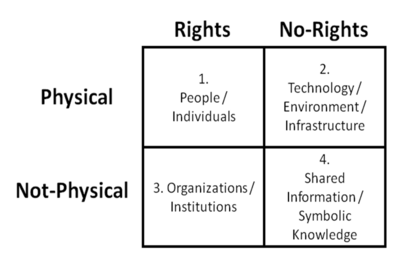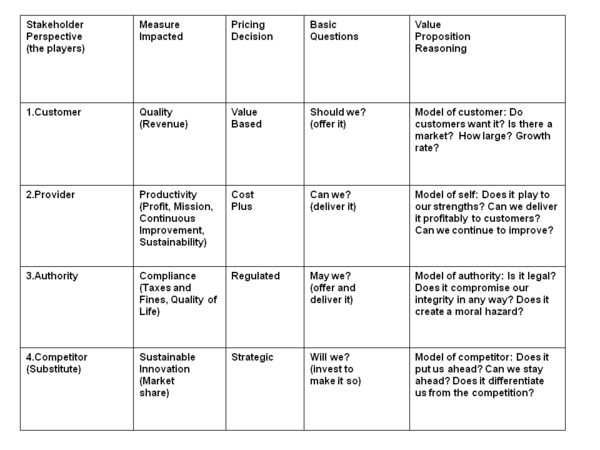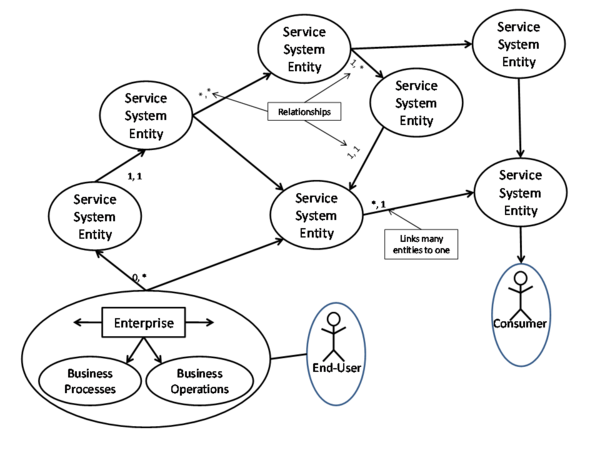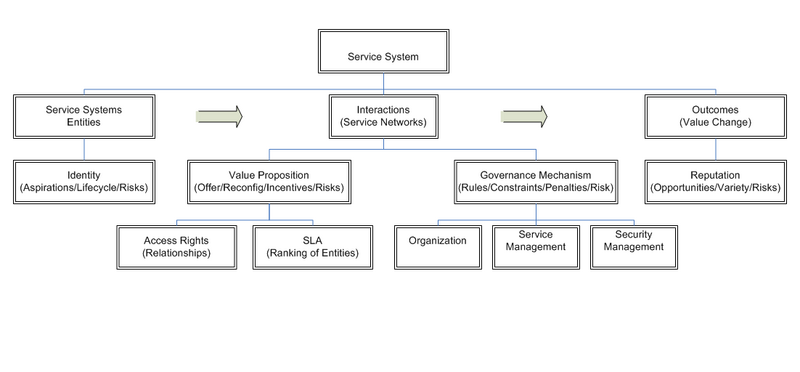Fundamentals of Services
Services are activities that cause a transformation of the state of an entity (a person, product, business, region, or nation) by mutually agreed terms between the service provider and the customer. Individual services are relatively simple, although they may require customization and significant back-stage support (e.g., database, knowledge management, analysis, forecasting, etc.) to assure quality and timely delivery. Product services are also relatively straightforward as product specifications, performance standards, quality control, installation guidelines, and maintenance procedures require good communication and understanding between providers and users. Business services can be rather complex; some may involve intensive negotiations, work process alignment, quality assurance, team collaboration, and service coproduction. Moreover, Chang (2010) states that: “Regional and National services are even more complex, as they may affect policy, custom regulations, export permits, local business practices, logistics, distribution, and other such issues" (see also Complexity).
The service and/or set of services developed and accessible to the customer (individual consumer or enterprise) are enabled by a service system. Service system stakeholders may interact to create a particular service value chain to be delivered with a specific objective (Spohrer and Maglio 2010). Service system entities dynamically configure four types of resources: people, technology/environment infrastructure, organizations /institutions, and shared information/symbolic knowledge. Service systems can be either formal or informal in nature. In the case of formal service systems, the interactions are contracted through service level agreements (SLA). Informal service systems can promise to reconfigure resources without a written contractual agreement; in the case of the emergency transports operations example discussed in the Service Systems Background article, there is no formal contractual agreement (i.e., SLA) between the user requesting the service and the agency providing the service other than a “promise” for a quick and efficient response. SLAs are written contracts between and among service system entities, as well as the legal system for enforcing the contracts. The study of informal service systems contains the study of relationships (communications, interactions, and promises) between service systems and social systems, cultural norms and beliefs, as well as political systems that can maintain those relationships (Spohrer and Kwan 2008). The resources are either physical or non-physical and have rights or no rights. See Figure 1 below:
Service Value Chain
SLAs and policies specify the conditions under which services system entities reconfigure access rights to resources by mutually agreed value propositions. Current management frameworks typically focus on single service system entity interfaces. They neither use SLAs for managing the implementation and delivery of services nor do they recognize/support the fact that many services may be composed of lower-level services, involve third-party providers, and rely on possibly complex relationships and processes among participating businesses, information communications, and technologies (CoreGRID 2007). While SLAs are mapped to the respective customer requirements, policies are provider-specific means to express constraints and rules for their internal operations. These rules may be independent of any particular customer (Theilmann 2009).
In service systems practice, the service value chain is described in terms of links among the entities; value could then be created and delivered in terms of e-services, such as business-to-business (B2B), business to consumer (B2C), business to government (B2G), government-to-business (G2B), government-to-government (G2G), government-to-consumer (G2C), etc. The emerging service in this case interacts or “co-produces” with their customer via the World Wide Web as compared to the physical environment in which the traditional, or brick and mortar, service enterprises interact with their customers.
The services sector requires information as input, involves the customer at the production/delivery stage, and employs mostly qualitative measures to assess its performance, i.e., technology-intensive services are “information-driven, customer centric, e-oriented, and productivity-focused" (Chesbrough 2011; Tien and Berg (2003); Hipel et al. 2007). Chang (2010) defines these features as the following:
- Information Driven: The creation, management, and sharing of information is crucial to the design, production, and delivery of services.
- Customer Centric: Customers are generally the co-producer of the services, as in the case of self-service. Customers require a certain degree of self-adaptation or customization and customers must be satisfied with the rendered services.
- E (electronics) Oriented: Services are becoming increasingly e-oriented. Thus, e-access, e-commerce, and e-customer management are crucial to e-services.
- Productivity Focused: Both efficiency and effectiveness are important in the design, delivery, and support of services.
- Value Adding: Services need to provide some value for the target clients. For profit-seeking service companies, the value produced for customers assures the company's profitability. For non-profit service entities, the value produced for customers reinforces the quality of a service entity's policy.
A service system is defined by its value co-creation chain in which stakeholders work in open collaboration to deliver consistently high quality service according to business goals, service goals, and customer goals. A value proposition can be viewed as a request from one service system to another to run an algorithm (the value proposition) from the perspectives of multiple stakeholders according to culturally determined value principles. The four primary stakeholder’s perspectives in regards to value are the customer, provider, authority, and the competitors. Figure 2 below depicts value calculations from multiple stakeholder perspectives.
From an engineering design point of view, the service and business goals are an entry point through which to analyze the business architectures (including organization and processes) needed, which in turn demand alignment between the information technology (IT) components and technology architecture to achieve the goals. From a systems engineering perspective, the next step is to identify service system entities that could participate in the service delivery (people, organizations, technologies, processes, etc.).
Service System Entities
Spath and Fahnrich (2007) defined a service meta-model comprised of nine types of entities:
- Customers: customer features, customer attitudes, customer preferences
- Goals: business goals, service goals, customer goals, enterprise culture goals
- Inputs: physical, human beings, information, knowledge, currency, constraints
- Outputs: physical, human beings, information, knowledge, currency, waste
- Processes: service provision, service operations, service support, customer relationships, planning and control, call center management
- Human Enablers: service providers, support providers, management, owner organization (enterprise)
- Physical Enablers: owner organization (physical), buildings, equipment, furnishings, location
- Informatics Enablers: information, knowledge, procedures and processes, decision support, skill acquisition
- Environment: political factors, economic factors, social factors, technological factors, environmental factors, legal factors (PESTEL), physical factors
Thus, a service or service offering is created by the relationships among service system entities (including information flows) through business processes into strategic capabilities that consistently provide superior value to the customer. If we were to represent the service as a network diagram (as in Figure 3 below), then the entities represent the nodes and the links represent the relationships between nodes.
Service System Hierarchy
But systems are part of other systems that are often expressed by systems hierarchies (Skyttner 2010) to create a multilevel hierarchy and thus the service system is composed of service system entities that interact through processes defined by governance and management rules to create different types of outcomes in the context of stakeholders with the purpose of providing improved customer interaction and value co-creation. Examples of service system entities are a business enterprise, a nation, or in the simplest form, a person (consumes and produces services).
Using the hierarchical approach, Spohrer conceptualizes an ecosystem at the highest level in which a service system is an entity of its own. We extend this concept to create the service system hierarchy as described in Figure 4 below (Spohrer 2011; Maglio and Spohrer 2008; Maglio et al. 2010):
Service System Attributes
The fundamental attributes of a service system include togetherness, structure, behavior and emergence. As mentioned earlier, today’s global economy is very competitive and a service system may be very competitive in a given environment at a given time (the business space) and the service system’s trajectory should be well controlled as time goes by (Qiu 2009) since services are “real time in nature and are consumed at the time they are co-produced” (Tien and Berg 2003), that is, during service transactions.
The service system should evolve and adapt to the conditions within the business space in a manner to ensure that the customized service behaves as expected. This adaptive behavior of service system implies that its design must be truly trans-disciplinary:
They must include techniques from social science (i.e., sociology, psychology, and philosophy) and management (i.e., organization, economics, and entrepreneurship). As a consequence, Systems, Man, and Cybernetics (SMC) must expand their systems (i.e., holistic oriented), man (i.e., decision-oriented), and cybernetics methods to include and be integrated with those techniques that are beyond science and engineering. (Hipel et al. 2007)
References
Works Cited
Chang, C.M. 2010. Service Systems Management and Engineering, Creating Strategic Differentiation and Operational Excellence. New York, NY, USA: John Wiley & Sons, Inc.
Chesbrough, H. 2011. Open Services Innovation: Rethinking Your Business to Grow and Compete in a New Era. San Francisco, CA, USA: Jossey-Bass.
CoreGRID. 2007. "Using SLA for Resource Management and Scheduling - A Survey. Technical Report 0096." Jülich & Dortmund, Germany: European Research Network on Foundations, Software Infrastructures and Applications for large scale distributed, GRID and Peer-to-Peer Technologies, Institute on Resource Management and Scheduling, accessed June 4, 2011. Available at: http://www.coregrid.net/mambo/images/stories/TechnicalReports/tr-0096.pdf.
Hipel, K.W., M.M. Jamshidi, J.M. Tien, and C.C. White. 2007. "The Future of Systems, Man, and Cybernetics: Application Domains and research Methods." IEEE Transactions on Systems, Man, and Cybernetics-Part C: Applications and Reviews. 37(5): 726-743.
Maglio, P., C. Kieliszewski, and J. Spohrer. 2010. Handbook of Service Science. New York, NY, USA: Springer Science amd Business Media.
Maglio P. and J. Spohrer. 2008. "Fundamentals of Service Science." Journal of the Academy of Marketing Science, 36(1): 18-20. DOI: 10.1007.
Qiu, R. 2009. "Computational Thinking of Service Systems: Dynamics and Adaptiveness Modeling." Service Science, 1(1): 42-55.
Skyttner, L. 2006. General Systems Theory: Perspectives, Problems, Practice, 2nd ed. Singapore: World Scientific Publishing Company.
Spath, D. and K.P. Fähnrich (eds.). 2007. Advances in Services Innovations. Berlin & Heidelberg, Germany: Springer-Verlag.
Spohrer, J.C. 2011. "Service Science: Progress & Directions." Presented at International Joint Conference on Service Science, 25-27 May 2011, Taipei, Taiwan.
Spohrer, J. and S.K. Kwan. 2009. "Service Science, Management, Engineering, and Design (SSMED): An Emerging Discipline-Outline & References." International Journal of Information Systems in the Service Sector, 1(3).
Spohrer, J., and P.P Maglio. 2010. "Chapter 1: Service Science: Toward a Smarter Planet." In Introduction to Service Engineering, edited by G. Salvendy and W. Karwowski, DOI: 10.1002. Hoboken, NJ: John Wiley & Sons.
Theilmann, W. and L. Baresi. 2009. "Chapter: Multi-level SLAs for Harmonized Management in the Future Internet." In Towards the Future Internet- A European Research Perspective, edited by G. Tselentis, J. Domingue, A. Galis, A. Gavras, D. Hausheer, S. Krco, V. Lotz, and T. Zehariadis. Amsterdam, The Netherlands: IOS Press.
Tien, J.M. and D. Berg. 2003. "A Case for Service Systems Engineering." Journal of Systems Science and Systems Engineering 12(1): 13-38.
Vargo, S.L. and M.A. Akaka. 2009. "Service-Dominant Logic as a Foundation for Service Science: Clarifications." Service Science 1(1): 32-41.
Primary References
Hipel, K.W., M.M. Jamshidi, J.M. Tien, and C.C. White. 2007. "The Future of Systems, Man, and Cybernetics: Application Domains and research Methods." IEEE Transactions on Systems, Man, and Cybernetics-Part C: Applications and Reviews 37(5): 726-743.
IFM. 2008. "Succeeding Through Service Innovation: A service perspective for education, research, business and government." University of Cambridge Institute for Manufacturing (IfM) and International Business Machines Corporation (IBM) report, Cambridge Service Science, Management and Engineering Symposium, July 13-15, 2007, Cambridge, UK.
Spath, D. and K.P. Fähnrich (eds.). 2007. Advances in Services Innovations. Berlin & Heidelberg, Germany: Springer-Verlag.
Spohrer, J.C. 2011. "Service Science: Progress & Directions." Presented at International Joint Conference on Service Science, 25-27 May 2011, Taipei, Taiwan.
Tien, J.M. and D. Berg. 2003. "A Case for Service Systems Engineering." Journal of Systems Science and Systems Engineering. 12(1): 13-38.
Additional References
No additional references have been identified for version 0.75. Please provide any recommendations on additional references in your review.
Comments from SEBok 0.5 Wiki
No comments were logged for this article in the SEBoK 0.5 wiki. Because of this, it is especially important for reviewers to provide feedback on this article. Please see the discussion prompts below.
SEBoK Discussion
Please provide your comments and feedback on the SEBoK below. You will need to log in to DISQUS using an existing account (e.g. Yahoo, Google, Facebook, Twitter, etc.) or create a DISQUS account. Simply type your comment in the text field below and DISQUS will guide you through the login or registration steps. Feedback will be archived and used for future updates to the SEBoK. If you provided a comment that is no longer listed, that comment has been adjudicated. You can view adjudication for comments submitted prior to SEBoK v. 1.0 at SEBoK Review and Adjudication. Later comments are addressed and changes are summarized in the Letter from the Editor and Acknowledgements and Release History.
If you would like to provide edits on this article, recommend new content, or make comments on the SEBoK as a whole, please see the SEBoK Sandbox.
blog comments powered by Disqus


